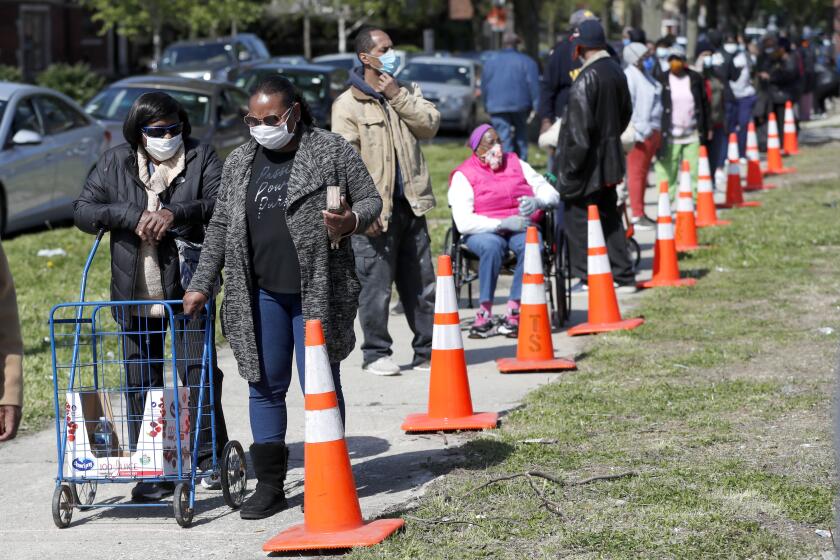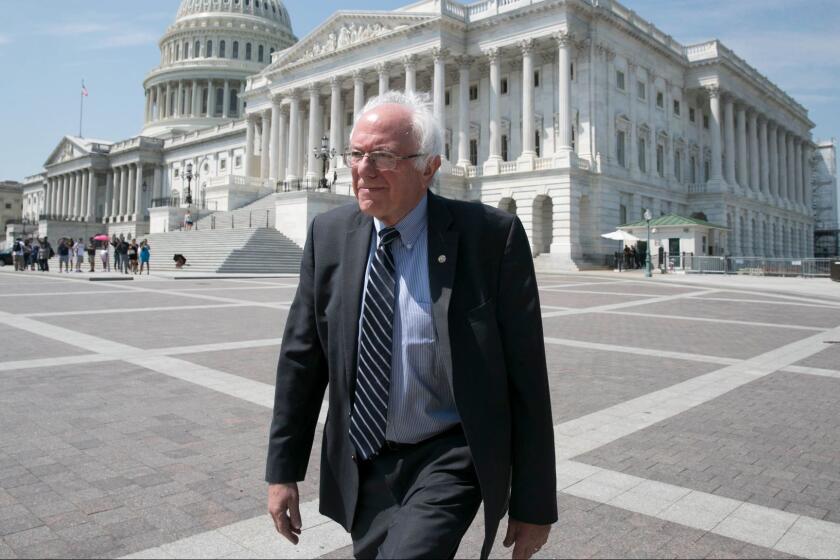Column: Stockton study shows that universal basic income can be life-changing

- Share via
The concept of universal basic income, which has received a boost from economic conditions during the pandemic, has just received another favorable vote.
This one comes from a study of a two-year guaranteed income project in Stockton, which delivered monthly no-strings-attached checks of $500 to 125 mostly low-income residents.
A preliminary analysis of the first year of the program, through February 2020, found that recipients were “healthier, showing less depression and anxiety and enhanced well-being” than those in a control group not receiving the stipends.
Poverty is not the result of individual bad decisions; it’s the result of policies that keep people down.
— Stacia West, University of Tennessee
They also experienced less month-to-month fluctuations in household income. Most notably, they had greater success finding full-time work or upgrading their employment. That turns on its head the conventional conservative argument that such programs will disincentivize the search for work and turn recipients into layabouts.
At the start of the study period in February 2019, according to the analysis, 28% of recipients had full-time employment; a year later, 40% did. By comparison, full-time employment in the control group rose only from 32% at the start to 37% after a year.
In other words, recipients were able to move into full-time work at about twice the rate of the control group.
“What we saw was that individuals were able to leverage the $500 in ways that enabled them to show up and fill out a job application — if you’re working part time and taking care of a child, there’s not a lot of time in your day,” says Stacia West, an expert in social work at the University of Tennessee. “Financial scarcity creates time scarcity.”
Get the latest from Michael Hiltzik
Commentary on economics and more from a Pulitzer Prize winner.
You may occasionally receive promotional content from the Los Angeles Times.
West says she was surprised at that finding, more so than others who helped create the program with more experience in the target community. “They were not shocked at all,” West told me. “They understood that when you’re financially constrained, you just don’t have the bandwidth to think about the future.”
West conducted the analysis with Amy Castro Baker of the School of Social Policy and Practice at the University of Pennsylvania. They’re working on a second-year analysis, due in September, that will bring their study to the end of the program, which is formally known as the Stockton Economic Empowerment Demonstration, or SEED. The final checks went out to recipients in January.
West and Baker helped design the Stockton program. But their findings do conform to those of analyses of other guaranteed-income programs.
If there’s one thing that many anti-poverty activists and free-market advocates agree on, it’s that our existing social safety net isn’t capable of dealing with the challenges presented by the evolution of the economy and of the very definition of work.
These include Alaska’s Permanent Fund, which has distributed money from the state’s oil boom since 1982; a casino dividend for members of North Carolina’s Eastern Cherokee Band of Indians starting in 1997; and 1970s experiments in “negative income tax” that provided low-income families in the U.S. and Canada with a guaranteed income via tax credits.
Studies of those programs found improvements in “mental and physical health, education outcomes, parenting [and] reduced criminal activity,” Ioana Marinescu of the University of Chicago reported in 2017.
The studies found either no impact or a slight decrease in labor participation, but some of that may have been due to recipients leaving workplace jobs to care for family members at home.
None found evidence that the stipends were treated as windfalls to be squandered. West and Baker say that less than 1% of the Stockton checks went for tobacco or alcohol. As an expert in universal basic income told me in 2017, “poor people and the middle class know best how to spend their money. They just don’t have it.”
The pandemic has underscored the virtues of universal basic income, in part by shining a spotlight on the structural inequities in the U.S. economy.
Lower-income households have become more vulnerable to losing their jobs over the last year or being pushed over the edge to poverty by cutbacks in work hours or higher expenses for child care because of school closures. They also have fewer options for avoiding infection, say by staying home rather than subjecting themselves to exposure at work.
Interest in universal basis income has been rising among liberals and conservatives alike, although they have different understandings of its possible virtues.
The coronavirus crisis may mean that the time has come for universal basic income’s closeup.
Conservatives view UBI as a possible replacement for the social safety net we have now, presumably at a lower cost. The right-wing political scientist Charles Murray, for example, has asserted that a guaranteed income of $10,000 a year would be enough to eliminate “Social Security, Medicare, Medicaid, welfare programs, social service programs, agricultural subsidies, and corporate welfare.”
Progressives tend to see UBI as a complement to the safety net, well-suited to changes in the modern workplace, including the growth of gig work.
The pandemic turbocharged interest in the idea. In one of the largest programs of its kind, the city of Compton has just launched the Compton Pledge, which will pay $300 to $600 a month to 800 Compton residents for two years.
The program is sponsored by the Fund for Guaranteed Income, a charity headed by Nika Soon-Shiong, daughter of Los Angeles Times owner Patrick Soon-Shiong and a co-director of the Compton Pledge.
Pilot programs have also been launched in St. Paul, Minn.; Richmond, Va.; Pittsburgh; and Oakland, among other communities.
One benchmark of how recipients are likely to spend these no-strings-attached stipends comes from the $1,200 that most adults received from the CARES Act, passed at the end of March.
Those payments functioned essentially in the same way as Stockton’s guaranteed payment — issued unconditionally for people with less than a specified income (the CARES Act checks went to individuals with less than $75,000 income and members of couples with less than $150,000 income).
The pattern of spending from the stimulus checks parallels that of the Stockton payments. According to the U.S Census Bureau, nearly 90% of adults in households with earnings of $25,000 or less spent their checks on household expenses.
About 80% of those recipients spent the money on food and 78% on rent, mortgage and utilities such as gas, electricity, cable, internet and cellphone services.
With Republicans seeming to have abandoned their repeal-or-bust attack on the Affordable Care Act, the path to improving Americans’ health coverage is wide open.
“These reports indicate the importance of the stimulus payments to help cover basic expenses such as housing and food,” the Census Bureau said.
Higher-income households — those with incomes above $75,000 — tended to use the checks more to pay down debts or add to savings.
West and Baker haven’t yet compiled full statistics from the second year of the Stockton project, which coincided with much of the pandemic lockdown.
There are signs, however, that recipients reacted to the prospect of lengthy stay-at-home orders the same way that families outside the program: by stockpiling food and other necessities.
“In February and March [2020] you see a pretty big spike in spending at grocery stores and on merchandise, probably at big box stores like Costco and Walmart,” West says.
“They were able to make one big trip to the grocery store, stock up on food and not go out and keep taking that risk,” West says.
One recipient who started experiencing COVID symptoms in the spring told the researchers that if she hadn’t had the $500 cushion, she would have gone to work. The income floor, in other words, allowed her to keep safer and keep co-workers and customers safe.
SEED was an initiative of former Stockton Mayor Michael D. Tubbs, who thought his city would be an ideal test case for the guaranteed income concept. Stockton had been especially hard hit by the Great Recession. The city’s median household income of $46,033 is about 40% below that of California as a whole.
The city is diverse — 27.6% Latino, 19.3% non-Hispanic white, about 11.5% Black and 22% Asian; the five most common languages spoken in the study group other than English are Spanish, Tagalog, Laotian, Hmong and Khmer.
The program called for the $500 monthly checks to be distributed among a sample of residents living in neighborhoods with less than the city median income, though there was no income limit for individual recipients. Invitations were mailed to 4,200 homes in those neighborhoods and the study and control groups selected randomly from respondents.
The SEED sponsors tried to arrange waivers with government programs so the additions to household income wouldn’t eliminate family eligibility.
That was possible with CALWorks, the state’s family assistance program, and the federal Temporary Assistance for Needy Families, or TANF, but not for food stamps or federally administered Supplemental Security Income, or SSI. The payments were regarded as gifts from a nonprofit organization and didn’t count against Medicaid eligibility.
The program counseled applicants to make sure they understood the implications for eligibility and maintained a “hold harmless” fund to cover unexpected losses in benefits. West says the Stockton households generally received much less from food stamps than they would gain from the program, so were willing to give up their food stamps if necessary.
The program’s funding came from private contributions and charitable foundations, not the public treasury.
Tubbs’s political adversaries, however, accused him of basing his political career on “just handing out taxpayer money to people was a good idea.” In part because of such accusations, he lost his bid for reelection as mayor last year.
The most important finding of the Stockton study may be one known to social scientists for decades about the care taken by lower-income households to manage their resources.
“Lower-income people budget better than higher-income people,” West says. “They know down to the penny what’s coming in and they make rational financial decisions based on that. Poverty is not the result of individual bad decisions; it’s the result of policies that keep people down.”
More to Read
Inside the business of entertainment
The Wide Shot brings you news, analysis and insights on everything from streaming wars to production — and what it all means for the future.
You may occasionally receive promotional content from the Los Angeles Times.













